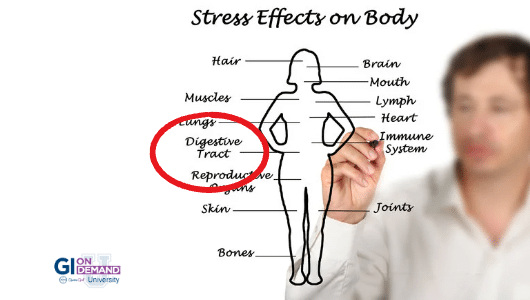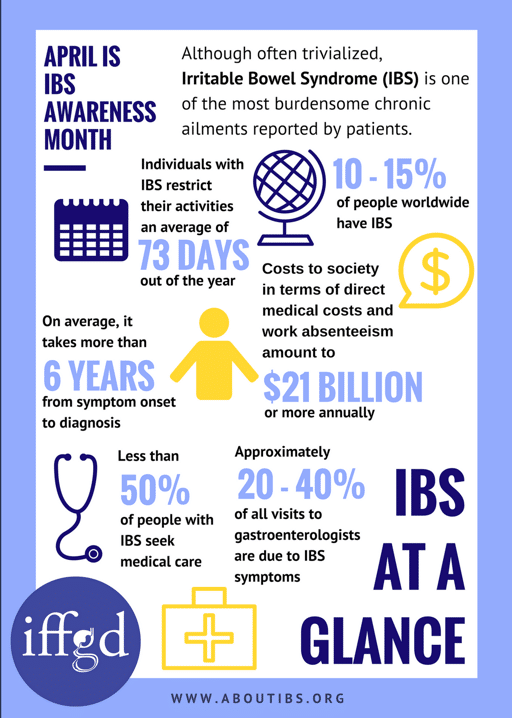Chronic IBS or Abdominal Pain? Ten Tips for Self-Management from Dr. Drossman
Irritable bowel syndrome (IBS) is one of the most common and burdensome chronic conditions, reported by patients, according to the International Foundation for Functional Gastrointestinal Disorders (IFFGD). With an estimated 30 to 45 million people in the United States — 10 to 15 percent of the population — affected by IBS, it’s the second leading cause of work absenteeism (second only to the common cold) and was found to cause those affected to restrict their personal and professional activities an average of 20 percent of the year (73 days).
 Dr. Douglas A. Drossman, Founder, Drossman Gastroenterology and President of the Rome Foundation
Dr. Douglas A. Drossman, Founder, Drossman Gastroenterology and President of the Rome Foundation IBS is typically characterized by recurring or chronic bouts of abdominal pain in association with a change in bowel habit (such as diarrhea or constipation). The pain may be relieved following a bowel movement and may be worsened after eating. Symptoms of IBS can flare-up unexpectedly and can change over time or even from day to day. Other symptoms may also occur, such as bloating, gas, or urgency.
But, despite the high prevalence and well-documented burden, much about IBS remains unknown, and myths and misconceptions about the disorder are common among patients as well as the general public, according to Dr. Drossman. For these reasons Dr. Drossman has set up the Drossman Center (www.drossmancenter.com) to provide educational resources to help clinicians learn how to provide more patient centered care to improve patient satisfaction, adherence to treatment and reduction in symptoms.
One of the most important things you can do for yourself or a loved one who is struggling with IBS symptoms, is to see your doctor to rule out a more serious disorder like celiac disease, inflammatory bowel disease or colorectal cancer. There are also several things you can do to help take control of the management of your pain and other symptoms.
Here are ten tips to empower you in your health journey:
1. Acceptance
Accept that the pain is there. Learn all you can about your condition and its management; knowledge is therapeutic
2. Get Involved
Take an active role in your care. Develop with your provider a partnership in the care. Understand your provider’s recommendations and maintain an open dialogue.
3. Set Priorities
Look beyond your symptoms to the things important in your life – do what is important. Eliminate or reduce what is not important.
4. Set Realistic Goals
Set goals within your power to accomplish. Break a larger goal into small manageable steps. Take the time to enjoy the success of reaching your goals.
5. Know Your Rights with your Healthcare Provider
You have the right to be treated with respect; To ask questions and voice your opinions; To disagree as well as agree; To say no without guilt.
6. Recognize and Accept Emotions
Mind and body are connected. Strong emotion affects pain. By acknowledging and dealing with your emotions you can reduce stress and decrease the pain.
7. Relaxation
Stress lowers pain threshold and increases symptoms. Relaxation helps reclaim control over your body and reduces pain. Examples of relaxation options to consider (taught or guided by an expert):
- Deep breathing exercises
- Progressive relaxation
- Gut-directed hypnosis
- Yoga and Meditation
8. Exercise
Diverts attention from your symptoms. Increases your sense of control in life. Helps you feel better about yourself.
9. Refocus
With these steps your symptoms are no longer the center of your life. Focus on abilities not disabilities. You will then see you can live a more normal life.
10. Reach Out
Share your thoughts and feelings with your provider. Interact with family and friends in healthy ways. Support others and seek support from them as well.
Related Gastro Girl Videos
Related Blog Posts
Related Resources
Listen to our
latest Podcast!







